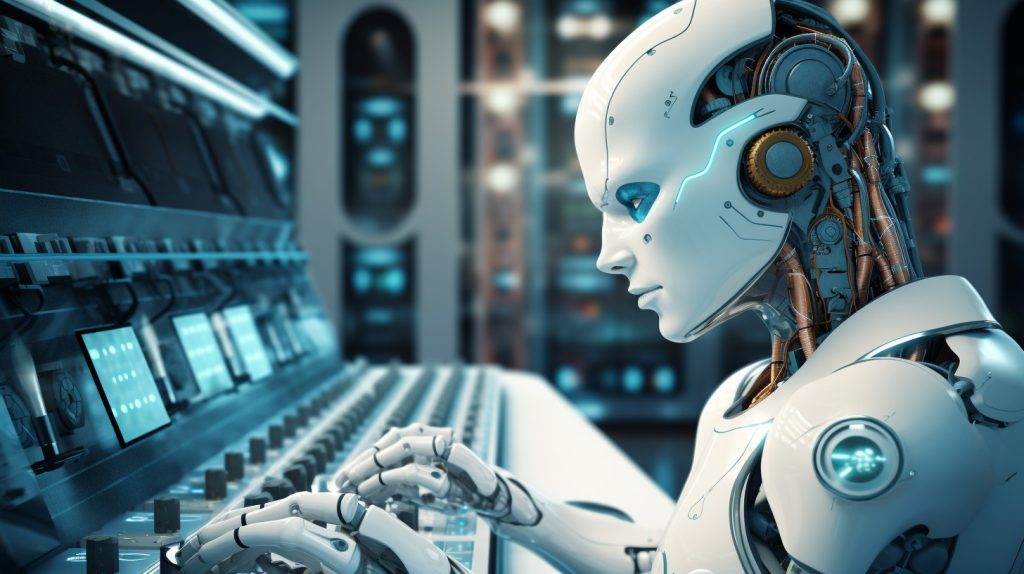Cario Growth Services Private Limited
Email: contact@cariogrowth.com
Work Hours
Monday to Friday: 9:30AM - 6PM
Saturday: 10AM - 5PM
Cario Growth Services Private Limited
Email: contact@cariogrowth.com
Work Hours
Monday to Friday: 9:30AM - 6PM
Saturday: 10AM - 5PM


In the ever-evolving landscape of technological innovation, robotic engineering stands as a vanguard, pushing the boundaries of what was once deemed impossible. As we embark on the journey into the future, the field of robotic engineering promises a landscape of unprecedented advancements that will transform industries, reshape economies, and redefine the very fabric of human life. This blog delves into the compelling facts that underpin the exciting trajectory of the future of robotic engineering.
AI-Powered Robotics:
The integration of artificial intelligence (AI) with robotics is catalyzing a transformative era. Future robots will not merely follow pre-programmed instructions but will possess the ability to learn, adapt, and make decisions based on real-time data. Machine learning algorithms will empower robots to navigate complex environments, perform intricate tasks, and even collaborate seamlessly with human counterparts.
Human-Robot Collaboration:
Contrary to dystopian visions, the future of robotic engineering is characterized by collaboration rather than replacement. Robots will increasingly work alongside humans, complementing their skills and enhancing productivity. This collaborative synergy will be particularly pronounced in industries such as manufacturing, healthcare, and logistics, where robots will handle repetitive tasks, freeing humans to focus on creative and complex endeavors.
Soft Robotics and Bio-Inspired Designs:
The rigid, metallic robots of today are giving way to a new generation of soft and bio-inspired robots. Mimicking the flexibility and adaptability of natural organisms, soft robots are poised to revolutionize fields like medical robotics, allowing for safer interactions with the human body. These bio-inspired designs are not only more versatile but also promise to unlock innovative solutions for tasks ranging from exploration in challenging terrains to delicate surgical procedures.
Autonomous Vehicles and Drones:
Robotic engineering is steering the automotive industry into an era of autonomous vehicles. From self-driving cars to unmanned aerial vehicles (UAVs), robots are set to redefine transportation. The integration of robotics in vehicles promises to enhance safety, reduce traffic congestion, and revolutionize the logistics and delivery sectors. The skies will be abuzz with drones facilitating rapid and efficient deliveries, surveying landscapes, and even providing emergency services.
Exoskeletons and Bionics:
The future of robotic engineering extends its reach to the human body with the development of exoskeletons and bionic prosthetics. These wearable robotic devices amplify human strength and mobility, offering life-changing solutions for individuals with mobility impairments. Beyond rehabilitation, exoskeletons will find applications in industries requiring heavy lifting, minimizing the risk of injuries and enhancing overall efficiency.
Swarm Robotics:
Taking inspiration from nature’s collective behaviors, swarm robotics involves the coordination of large groups of simple robots to perform complex tasks. This approach is gaining traction in applications such as search and rescue missions, environmental monitoring, and agriculture. The collective intelligence of swarms enables them to adapt to dynamic environments and accomplish tasks more efficiently than individual robots.
Space Exploration and Robotic Missions:
Robotic engineering is pivotal in our exploration of outer space. Robots are not only serving as precursors to human exploration but are also essential in conducting scientific experiments and gathering data in inhospitable environments. NASA’s Mars rovers, like Curiosity and Perseverance, are prime examples of robotic ingenuity expanding the scope of human knowledge beyond Earth.
Conclusion:
The future of robotic engineering is a tapestry woven with the threads of artificial intelligence, human-robot collaboration, bio-inspired designs, and innovative applications across diverse industries. As these facts unfold, the once-fantastical realms of science fiction are becoming the tangible reality of tomorrow. Robotic engineering is not just about machines; it’s about redefining possibilities, enhancing human potential, and charting a course toward a future where robots and humans coexist in a harmonious dance of progress. The robotic revolution is underway, and its impact will resonate across every facet of our lives.
About Cario Growth:
Interested to learn more about Robotic Engineering? Interested in earning a job at Robotic Engineering industry? At Cario Growth, we teach & train you in the fundamentals of Robotic Engineering with the “First Principles Approach” . We have collaborated with Industrial Experts. Note: Since we are more like an educational institutions teaching the innovative programs of tomorrow, as per regulations we cannot provide you a degree or diploma. However, we provide you with Industrial training certifications. Visit cariogrowth.com to know more. contact@cariogrowth.com
